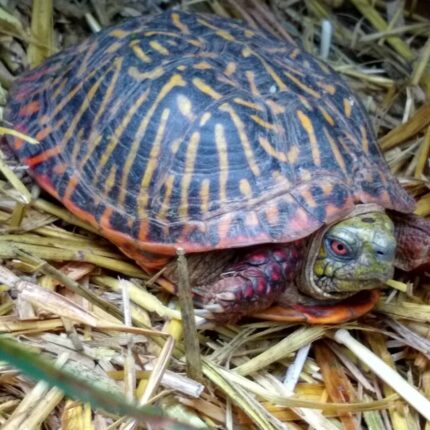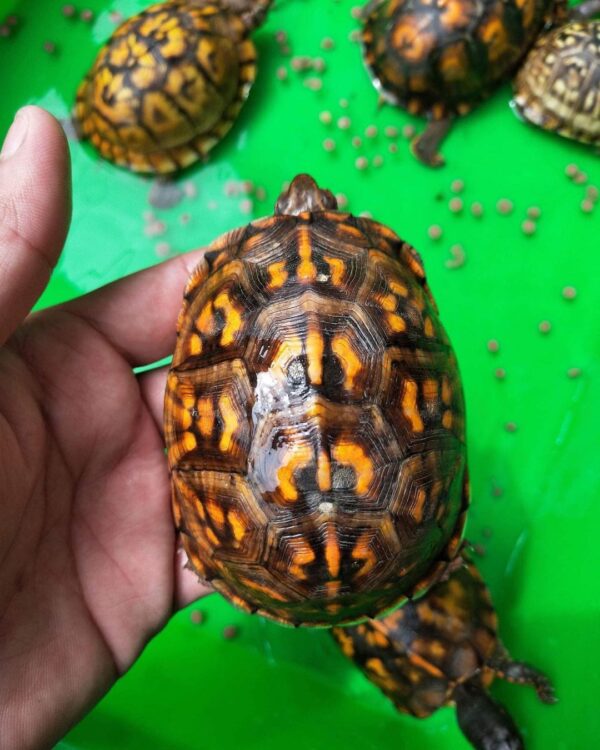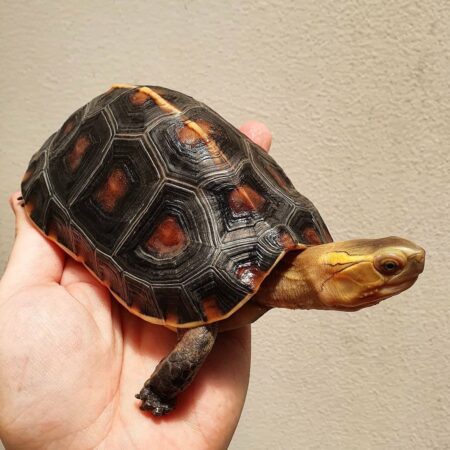Gulf Coast box turtles are the largest subspecies of the common box turtle. They have a large, domed upper shell that’s typically dark brown or black with yellow stripes or blotches. They’re not aquatic turtles, but they do love to be around water. In the wild, they’re often found in marshes and swamps. As pets, these turtles have complex housing and dietary needs, so some turtle experience is ideal before acquiring one.
Gulf Coast Box Turtle Behavior and Temperament
Gulf Coast box turtles usually aren’t suitable pets for young children or for new pet owners. This is due to their complex care requirements, as well as their susceptibility to stress, which can greatly impact their health. Gulf Coast box turtles are generally shy and don’t like to be handled. They need plenty of places to hide to feel comfortable in their environment. However, once they’ve acclimated to their space, many pet turtles will learn to recognize their keepers and even beg for food.
Housing the Gulf Coast Box Turtle
While it is possible to keep Gulf Coast box turtles (especially hatchlings and juveniles) in a large indoor terrarium with a heat source, they do much better in outdoor pens where the climate is agreeable. Most experts recommend a minimum of 4 feet by 8 feet for a box turtle’s pen, especially if you have multiple turtles or it’s a full-time home. A smaller pen will suffice if space is limited, but avoid going below 4 feet by 4 feet. A cramped space can stress a turtle. The enclosure should be in a sunny location, though it should always have a shady spot.
Heat
If you’re keeping your Gulf Coast box turtle indoors, a terrarium with a heat lamp is the way to go. They prefer temperatures between 80 and 85 degrees Fahrenheit with a basking spot that’s around 90 degrees Fahrenheit. Nighttime temperatures should not drop below 70 degrees. Do not use a heat rock, as it can cause burns.
Light
Gulf Coast box turtles need UVB lighting either from natural sunlight or a UVB lamp to metabolize calcium in their diets. Without it, they can develop metabolic bone disease and even die. When housed indoors, turn off the lamp at night to mimic a natural day-night cycle.
Humidity
Because this species lives near water, it likes a high humidity level of around 60% to 90%. Maintain this through misting your turtle’s enclosure daily.
Substrate
Substrate is the material used to line the bottom of your turtle’s enclosure. Not only can it mimic the animal’s natural environment, but it also can help to maintain the humidity level and satisfy the turtle’s burrowing instinct. Thus, substrate that retains some moisture is ideal for Gulf Coast box turtles. Many owners opt for chemical-free topsoil, leaves, and moss. Layer it at least 4 inches deep to allow your turtle to burrow.
Moreover, most box turtles are burrowers, so make your pen escape-proof with walls buried deep into the ground. Paving stones placed on the ground around the perimeter can help to discourage digging. It’s best to build the enclosure out of solid material; if the turtle doesn’t see what’s outside its cage, it’s less likely to try to climb or burrow out to get there.
Food and Water
Gulf Coast box turtles are omnivores and need a varied diet. As adults, their diet should be around 40 percent vegetables, fruits, and grasses, with the rest made up of low-fat protein sources, such as earthworms, slugs, snails, mealworms, crickets, grasshoppers, and small fish. Hatchlings and juvenile turtles are more carnivorous than adult turtles, so bear in mind your turtle’s age when preparing its meals.
It’s particularly important to make sure your Gulf Coast box turtle gets the right calcium and phosphorous balance in its diet to prevent metabolic bone disease. Dark leafy greens, such as parsley, dandelion greens, spinach, and collard greens, all are good vegetable options. Blueberries, grapes, apples, and papaya are good fruit choices.
Fresh prey insects from pet stores and bait shops are the best protein sources for a box turtle. Avoid feeding a captive Gulf Coast box turtle insects caught outside because you have no way of measuring pesticide exposure. Commercial box turtle diets are available, but they’re typically only fed as supplements within a varied diet.
In general, feed your turtle every two to three days. But consult with your veterinarian about the proper quantity and timing of meals based on your turtle’s age, size, and health. You also should provide an easily accessible shallow pan of clean water at all times. The turtle will use this for drinking and soaking, so be sure to change the water regularly.
Common Health and Behavior Problems
In addition to metabolic bone disease, which can lead to weakened bones and death, Gulf Coast box turtles are prone to respiratory infections. These infections are usually caused by insufficient humidity, with symptoms including wheezing and mucus around the mouth and nasal passages. If your turtle experiences frequent respiratory infections, it could be a sign of vitamin A deficiency.
Parasitic infections are another common ailment seen in turtles. They don’t always show symptoms, but they can be diagnosed by a veterinarian who specializes in reptiles. And like most turtles, box turtles are susceptible to a painful condition known as shell rot, which is caused by a bacterial or fungal infection. The shell will appear cracked or dry, and it might emit an unpleasant odor.
If your turtle is showing symptoms of any of these illnesses, don’t try to treat them without consulting with your vet.
Choosing Your Gulf Coast Box Turtle
Gulf Coast box turtles aren’t hardy animals and thus aren’t suitable for beginner turtle keepers. They have very specific needs, are sensitive to stress, and are difficult to keep in captivity.
When acquiring a Gulf Coast box turtle, select a captive-bred specimen from a reputable breeder, or visit a rescue organization. This way, you avoid supporting the capture of wild turtles for the pet trade, which often results in subpar care and sick animals. Expect to pay between $100 and $400 on average. Make sure the turtle has clear eyes and no mucus around its nose or mouth. Also, its shell should feel solid, and it shouldn’t have any bumps or swelling along its body.













Reviews
There are no reviews yet.